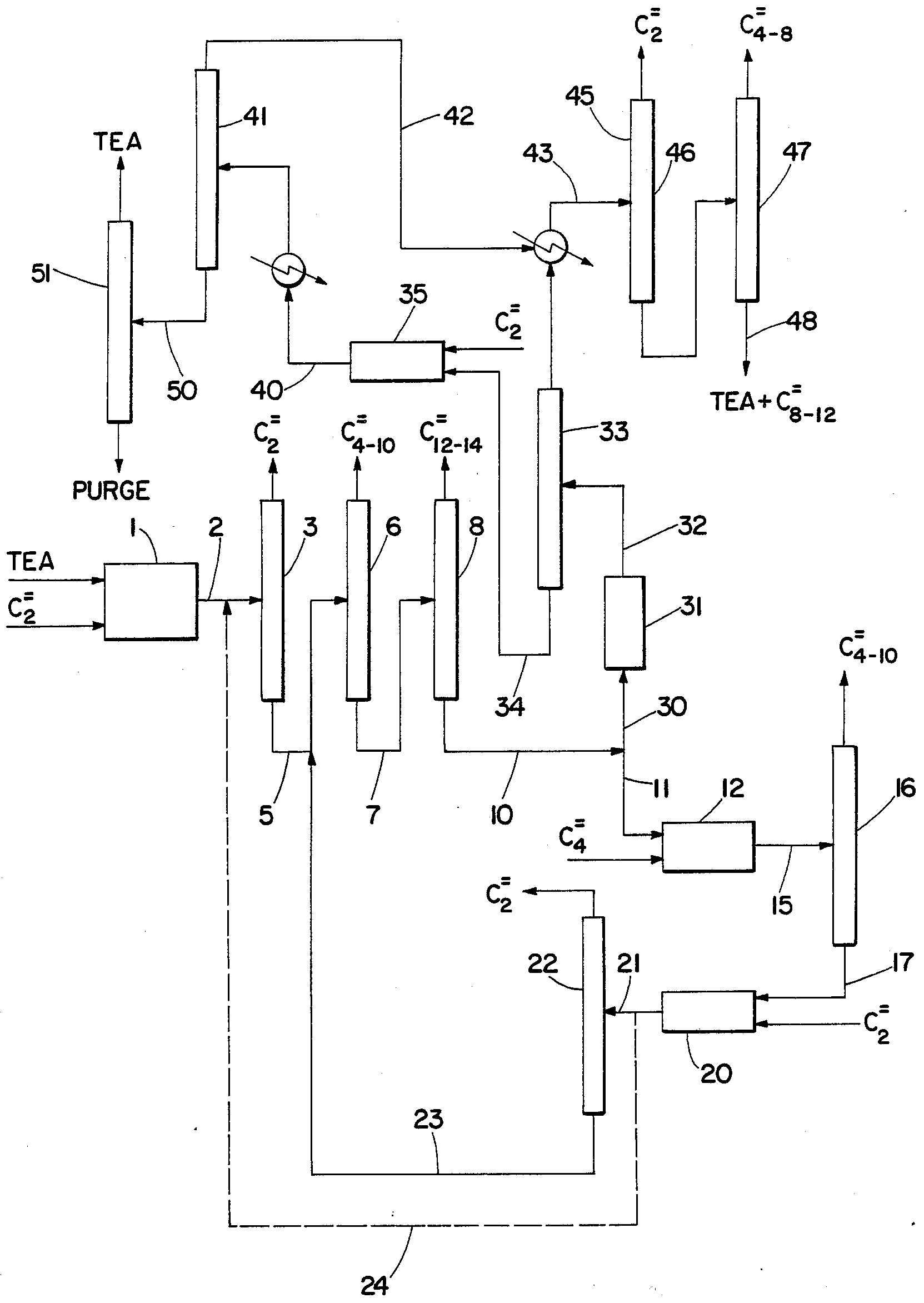History
Originally developed by the Ethyl Corporation and described in the United States Patents 4,935,569[1.a], 5,210,338[1.b], 5,276,220[1.c], and other related patents cited therein, the INEOS Ethylene Oligomerization Process is commonly referred to as the 'Ethyl Process'.
Ethyl’s Linear Alpha-Olefins (LAO) business became part of Albemarle Corporation in 1994, when the former split out its chemical activities that were not related to lubricants and fuel oil additives. Subsequently, Albemarle sold its LAO, polyalpha-olefin and detergent alcohol businesses to Amoco Corp. in 1996. The latter then merged with British Petroleum plc (BP) to form BP Amoco Corp. within North America. The company later changed its name to BP.[2]
BP’s refining, olefins and derivatives business (Innovene) was fully acquired by INEOS in 2005.[3]
Process Description
The INEOS Ethylene Oligomerization Process is a Full-Range type of ethylene oligomerization technology catalysed by Alkylaluminum compounds operating in two separate steps combining stoechiometric and catalytic chain-growth reactions to provide a mixture of C4-C30 alpha-olefins with a Poisson distribution.[4-6]
In a first stage, ethylene is oligomerized by trialkylaluminum (AlEt3) growth promotion under low temperature and pressure conditions. In a second displacement step, the trialkylaluminum compounds formed in the first stage are displaced with ethylene under high temperature and pressure conditions to yield linear alpha-olefins in the C4-C18 range and to regenerate the triethylaluminum for recycle.[1,2,4-7]
The product separation step processes unconverted ethylene from the growth and displacement reactor stages for recycle and separates the individual C4-C18 olefins. The linear alpha-olefins are distilled at 90-125°C.[2]
Typical linear alpha-olefin content ranges from 93.7% to 99.7% for C4-C12, with the 1-butene fraction being the most pure. Impurities include paraffins, internal olefins and branched olefins. This process yields higher amounts of the branched oligomers than the one-step reaction because of the continued reaction of alpha-olefin product in the recycle step. These branched products are concentrated in the higher-carbon-number C14-C18 ranges, whereas the shorter-chain-length linear alpha-olefins have lower concentrations of the branched impurities. Typical alpha-olefin content for C14 is 81.0% and 62.7% for C16-C18.[2]
To satisfy changing market demands, distribution of chain lengths can be altered by changing reaction conditions. Automated computer control allows for shifting the production of chain-length distributions. Current production emphasis is on the lower-carbon-number olefins, to supply the comonomer, plasticizer and polyalphaolefin markets. The typical product distribution by chain-length range exhibits a Poisson distribution, as follows:[2]
| alpha-olefin: |
C4 |
C6-C10 |
C12-C14 |
C16-C18 |
C20+ |
| weight-%: |
12 |
54-60 |
20-25 |
5-7 |
2 |
BP used this process in its plant at Pasadena, Texas (which closed in 2005). INEOS uses similar technology with the addition of a butene recycle loop in a plant at Feluy, Belgium that began operations in mid-1992 and at Joffre, Alberta (Canada) that became operational in May 2002. The resulting product distribution is as follows:[2]
| alpha-olefin: |
C4 |
C6-C10 |
C12-C18 |
C20+ |
| weight-%: |
0 |
70-77 |
21-28 |
2 |
Process Flow Diagram
The process is best described by reference to the schematic flow diagram shown in Fig. 1. Detailed operating conditions and processing parameters are described in U.S. Patent 4,935,569.[1.a]
Figure 1 - Schematic Flow Diagram of the INEOS alpha-olefin process.[1.a]

Legend: Cn= represents terminal olefins with n carbon atoms; 1. First ethylene growth chain reactor; 2. Conduit; 3. Vapor-liquid separator; 5. Conduit; 6. Distillation unit; 7. Conduit; 8. Vacuum rectification colum; 10. & 11. Conduits; 12. Butene displacement zone; 15. Conduit; 16. Distillation unit; 17. Conduit; 20. Second ethylene chain growth reactor; 21. Conduit; 22. Ethylene separator; 23., 24. & 30. Conduits; 31. Ethylene displacement zone; 32. Conduit; 33. Distilation unit; 34. Conduit; 35. Second ethylene displacement unit; 40. Conduit; 41. Distillation unit; 42. Conduit; 43. Combined stream; 45. Ethylene flash unit; 46. Conduit; 47. Distillation unit; 48. & 50. Conduits; 51. Vacuum rectification column; Distillation area is not shown on the diagram.
References
- a. Alvin E. Harkins, Layne W. Summers, U.S. Patent 4,935,569 filed 29th Jun 1989 by Ethyl Corporation, VA, Alpha-olefin process, Currently assigned to Ineos USA LLC.
b. Edward G. Samsel, David C. Eisenberg, U.S. Patent 5,276,220 filed 18th Jun 1992 by Ethyl Corporation, Richmond, VA, Actinide catalyzed chain growth process, Currently assigned to Ineos USA LLC.
c. Edward G. Samsel, U.S. Patent 5,210,338 filed 12th May 1992 by Ethyl Corporation, Richmond, VA, Catalyzed Chain Growth Process, Currently assigned to Ineos USA LLC.
- Elvira O. Camara Greiner, Yoshio Inoguchi, Nov 2010, Linear alpha-Olefins Chemical Economics Handbook 681.5030, IHS Chemical.
- INEOS Group, Businesses, INEOS Oligomers, Business, History.
- Astrid Cordier, 15th Nov 2019, Oligomerization and polymerization of ethylene by phenoxy-imine titanium catalysts, PhD Thesis, Université de Lyon, NNT: 2019LYSE1229.
- Lappin G.R., Sauer J.D., 1989, Alphaolefins Applications Handbook, Marcel Decker Inc., Berkeley, CA.
- Vogt D., 1996, Applied Homogeneous Catalysis with Organometallic Compounds, Cornils B., Hermann W.A. (eds.), VCH, New York, Vol. 1, pp. 245-258.
- Belov, G.P., Matkovsky, 2010, Processes for the production of higher linear α-olefins, Pet. Chem. 50, 283–289.














